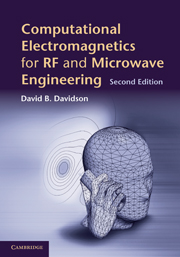Book contents
- Frontmatter
- Dedication
- Contents
- Preface to the second edition
- Preface to the first edition
- Acknowledgements
- To the reader
- List of notation
- 1 An overview of computational electromagnetics for RF and microwave applications
- 2 The finite difference time domain method: a one-dimensional introduction
- 3 The finite difference time domain method in two and three dimensions
- 4 A one-dimensional introduction to the method of moments: modelling thin wires and infinite cylinders
- 5 The application of the FEKO and NEC-2 codes to thin-wire antenna modelling
- 6 The method of moments for surface modelling
- 7 The method of moments and stratified media: theory
- 8 The method of moments and stratified media: practical applications of a commercial code
- 9 A one-dimensional introduction to the finite element method
- 10 The finite element method in two dimensions: scalar and vector elements
- 11 The finite element method in three dimensions
- 12 A selection of more advanced topics in full-wave computational electromagnetics
- Appendix A The Whitney element
- Appendix B The Newmark-β time-stepping algorithm References
- Appendix C On the convergence of the MoM Reference
- Appendix D Useful formulas for simplex coordinates
- Appendix E Web resources
- Appendix F MATLAB files supporting this text
- Index
- References
8 - The method of moments and stratified media: practical applications of a commercial code
Published online by Cambridge University Press: 05 July 2014
- Frontmatter
- Dedication
- Contents
- Preface to the second edition
- Preface to the first edition
- Acknowledgements
- To the reader
- List of notation
- 1 An overview of computational electromagnetics for RF and microwave applications
- 2 The finite difference time domain method: a one-dimensional introduction
- 3 The finite difference time domain method in two and three dimensions
- 4 A one-dimensional introduction to the method of moments: modelling thin wires and infinite cylinders
- 5 The application of the FEKO and NEC-2 codes to thin-wire antenna modelling
- 6 The method of moments for surface modelling
- 7 The method of moments and stratified media: theory
- 8 The method of moments and stratified media: practical applications of a commercial code
- 9 A one-dimensional introduction to the finite element method
- 10 The finite element method in two dimensions: scalar and vector elements
- 11 The finite element method in three dimensions
- 12 A selection of more advanced topics in full-wave computational electromagnetics
- Appendix A The Whitney element
- Appendix B The Newmark-β time-stepping algorithm References
- Appendix C On the convergence of the MoM Reference
- Appendix D Useful formulas for simplex coordinates
- Appendix E Web resources
- Appendix F MATLAB files supporting this text
- Index
- References
Summary
Printed antenna and microstrip technology: a brief review
Microstrip patch antennas are an example of a large class of modern antennas known as “printed antennas.” Microstrip was originally developed in the early 1950s as a transmission line, and the first publication on using this structure as a radiator appears to have been by Deschamp in 1953 [1, Section 1.1]. Almost 20 years then passed until the first patent of the modern microstrip antenna was registered in 1973 by Munson, although the structure was independently discovered in at least one other location.
Microstrip antennas are generally constructed using the same photo lithographic process used to create printed circuit boards. In their simplest form, radiation is due primarily to energy leaking out of the cavity formed by the patch located close to a ground plane; physically, the patch is simply a very wide microstrip line. For the basic rectangular patch, the radiation from two opposite sides reinforces, whereas that from the other two sides cancels. The patch is usually supported on a dielectric substrate of some form, primarily for structural reasons. Typical materials are Teflon and glass-reinforced plastics, as used in printed circuit board technology. Typical material properties for these are εr in the range from 2—2.5, and tan δ from 0.0004—0.002. High-εr substrates such as alumina ceramics produce physically small patches, but with very limited bandwidth. Typical material properties in this case are: εr 9.7—10.3, tan δ ≈ 0.0004. For some applications, plastic foam substrates have been used.
Information
- Type
- Chapter
- Information
- Computational Electromagnetics for RF and Microwave Engineering , pp. 300 - 316Publisher: Cambridge University PressPrint publication year: 2010
